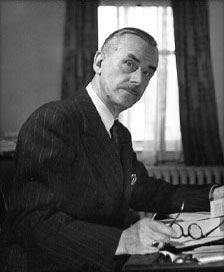Modris Eksteins notes the similarities between Aschenbach and the Russian choreographer Sergei Diaghilev, writing that, although the two never met, “Diaghilev knew Mann’s story well. He gave copies of it to his intimates”. Diaghilev often stayed at the same hotel as Aschenbach, the Grand Hotel des Bains, and took his young male lovers there. Eventually, like Aschenbach, Diaghilev died in the hotel.
The real Tadzio
In her 1974 Unwritten Memories, Mann’s wife Katia recalls that the idea for the story came during an actual vacation in Venice at the Grand Hôtel des Bains on the Lido, which they took in the summer of 1911:
All the details of the story, beginning with the man at the cemetery, are taken from actual experience […]. In the dining-room, on the very first day, we saw the Polish family, which looked exactly the way my husband described them: the girls were dressed rather stiffly and severely, and the very charming, beautiful boy of about thirteen was wearing a sailor suit with an open collar and very pretty lacings. He caught my husband’s attention immediately.
This boy was tremendously attractive, and my husband was always watching him with his companions on the beach. He didn’t pursue him through all of Venice—that he didn’t do—but the boy did fascinate him, and he thought of him often. […] I still remember that my uncle, Privy Counsellor Friedberg, a famous professor of canon law in Leipzig, was outraged: “What a story! And a married man with a family!”
— Katia Mann, Unwritten Memories
The boy who inspired “Tadzio” was perhaps Baron Władysław Moes, whose first name was usually shortened as Władzio or just Adzio. This story was uncovered by Andrzej Dołęgowski, Thomas Mann’s translator, around 1964, and was published in the German press in 1965.
Moes was born on 17 November 1900 in Wierbka, the second son and fourth child of Baron Aleksander Juliusz Moes. He was aged 10 when he was in Venice, significantly younger than Tadzio in the novella. Baron Moes died on 17 December 1986 in Warsaw and is interred at the graveyard of Pilica, Silesian Voivodeship. He was the subject of the biography The Real Tadzio (Short Books, 2001) by Gilbert Adair. Ironically, while in the novella Aschenbach is Silesian, it was Moes who was really Silesian.
However, serious doubts about this identification were raised in an article in Der Spiegel in 2002, mainly because of the significant differences in age and physical appearance between the Tadzio figure of the novella and Moes. The same article offers another candidate in the form of Adam von Henzel-Dzieduszycki, a Polish-Austrian, who was also on vacation in the same hotel in the summer of 1911 and was 15 years old at the time.
English translations
An English translation by Kenneth Burke was published in periodical form in The Dial in 1924 over three issues (vol. LXXVI, March to May, issues # 3–5, Camden, NJ, USA). This translation was published in book form the following year by Alfred A. Knopf as Death in Venice and Other Stories. W. H. Auden called it the definitive translation, but it is unclear to what other translations Auden was comparing it.
Helen Tracy Lowe-Porter’s authorized translation, published in 1922 in Mann’s Stories of Three Decades, has been less well received by critics due to Lowe-Porter’s treatment of sexuality and homoeroticism. In the Oxford Guide to Literature in English Translation it is criticized for its “puritanism”, which saw Lowe-Porter “tone down Mann’s treatment of sexuality, especially homoeroticism”. The author considers the result “disastrous” and sees “a reworked, sanitized version of the text” by Mann.
A translation published in 2005 by Michael Henry Heim won the Helen and Kurt Wolff Translator’s Prize.
Other English translations include those by David Luke (1988), Clayton Koelb (1994), Stanley Applebaum (1995), Joachim Neugroschel (1998), Martin C. Doege (2010), and Damion Searls (2023). Lesley Chamberlain writes that her translation of Death in Venice will be published in 2026.
Adaptations
A film adaptation of Death in Venice starring Dirk Bogarde was made by Luchino Visconti in 1971.
Benjamin Britten transformed Death in Venice into an opera, his last, in 1973.
The novella was dramatised by Peter Wolf for BBC Radio 3 in 1997.
John Neumeier adapted it for a ballet for his Hamburg Ballet company in December 2003.
A stage production in 2013, directed by Thomas Ostermeier at the Schaubühne theatre in Berlin, titled Death in Venice/Kindertotenlieder, took elements from Gustav Mahler’s song cycle Kindertotenlieder.
In 2023 Luk De Bruyker transformed the book into a stage play titled Dood in Venetië in Ghent, Belgium, with Koen Crucke in the lead role.
